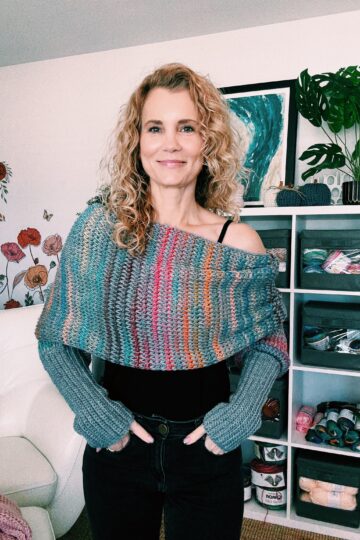Have you ever struggled with Tunisian crochet projects that won't lie flat? The curl can be a big problem for crocheters. But don't worry, I'm here to help. In this guide, I'll share tips and techniques to prevent Tunisian crochet curling and get flat stitches every time.
Do you think every Tunisian crochet project will curl no matter what? If so, you're not alone. Many crocheters feel like curling is a given with Tunisian crochet. But it doesn't have to be.
Whether you're new to crochet or have been doing it for years, I'll share how to control tension and pick the right yarn and hook. You'll also learn about blocking methods to make your Tunisian crochet projects look perfect.
And best of all, I'll share some of my favorite Tunisian crochet stitches and patterns that don't curl!
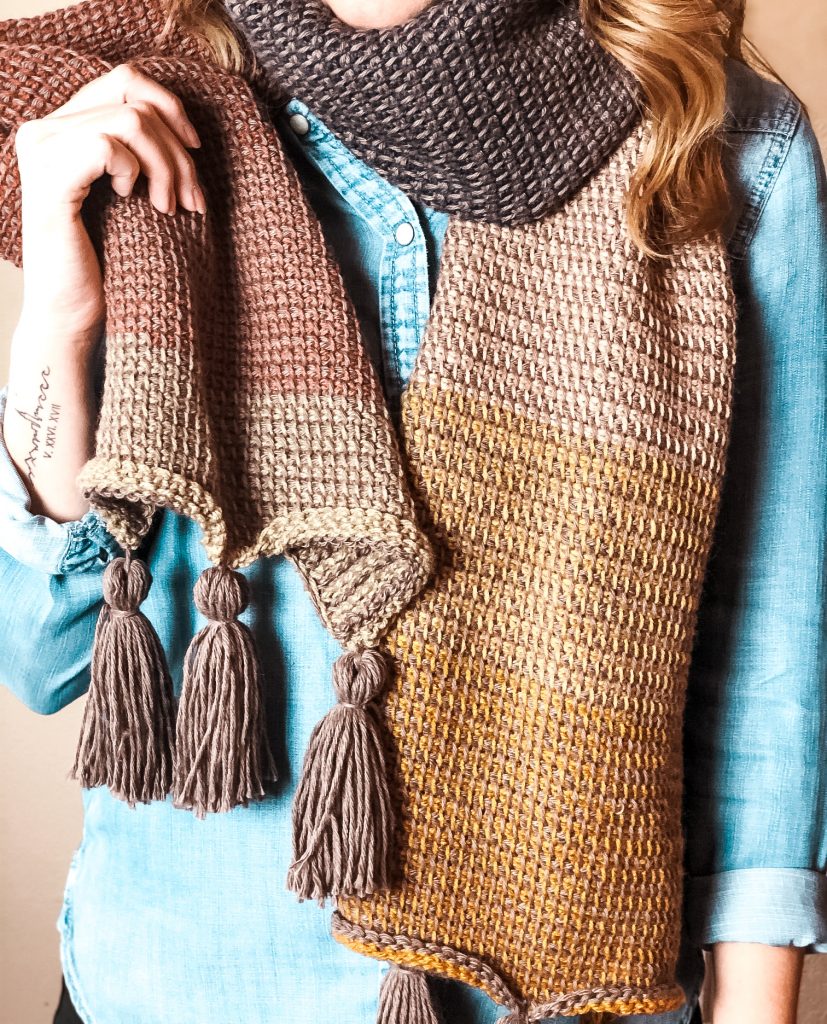
See the curling at the ends of the Autumn Ombre Scarf? This was one of the first Tunisian crochet patterns I designed, and I was still learning all about this incredible craft. Thankfully, I now know how to prevent curling and eliminate it!
Are you a beginner Tunisian crocheter? This article shares the difference between regular crochet and Tunisian crochet.
Key Takeaways
- Understand the causes of Tunisian crochet curling and how to prevent it.
- Learn techniques for controlling tension and selecting the right yarn and hook to minimize curling.
- Discover effective blocking methods to straighten and flatten Tunisian crochet projects.
- Avoid common mistakes that contribute to curling, such as uneven tension and improper hook size.
- Explore Tunisian crochet patterns and design techniques that minimize or don't curl. (They do exist!)
Understanding Tunisian Crochet Curling
Getting a flat Tunisian crochet project can be challenging, as this method often makes edges curl. But don't worry—knowing why it curls is the first step to stopping it.
Tunisian crochet, a unique technique combining elements of knitting and crochet, often results in a common challenge for crafters: curling. This curling happens because of the nature of the stitches used in Tunisian crochet.
What Causes Curling in Tunisian Crochet?

Basic Tunisian crochet stitches, such as the Tunisian Simple Stitch (TSS), naturally tend to lean forward due to how the yarn is pulled up through the fabric. When several rows are worked, this forward-leaning effect accumulates, causing the edges of the fabric to curl.
The fabric’s dense texture, created by retaining loops on the hook throughout the row, also contributes to this curling tendency. Unlike traditional crochet, where each stitch is completed before moving on to the next, Tunisian crochet retains multiple stitches on the hook, creating tension and causing the edges to curl inward.
Moreover, the curling is also influenced by the type of yarn and hook size used. Heavier yarns and smaller hooks can exacerbate curling by creating a tighter, more compact fabric that naturally wants to curl in on itself.
However, this is not an irreversible problem. Understanding why Tunisian crochet curls is the first step in preventing it.
Techniques such as using a larger hook, blocking the finished piece, or incorporating different stitches that counteract the curl can help manage and reduce this issue, allowing crafters to achieve a beautiful, flat finish in their Tunisian crochet projects.
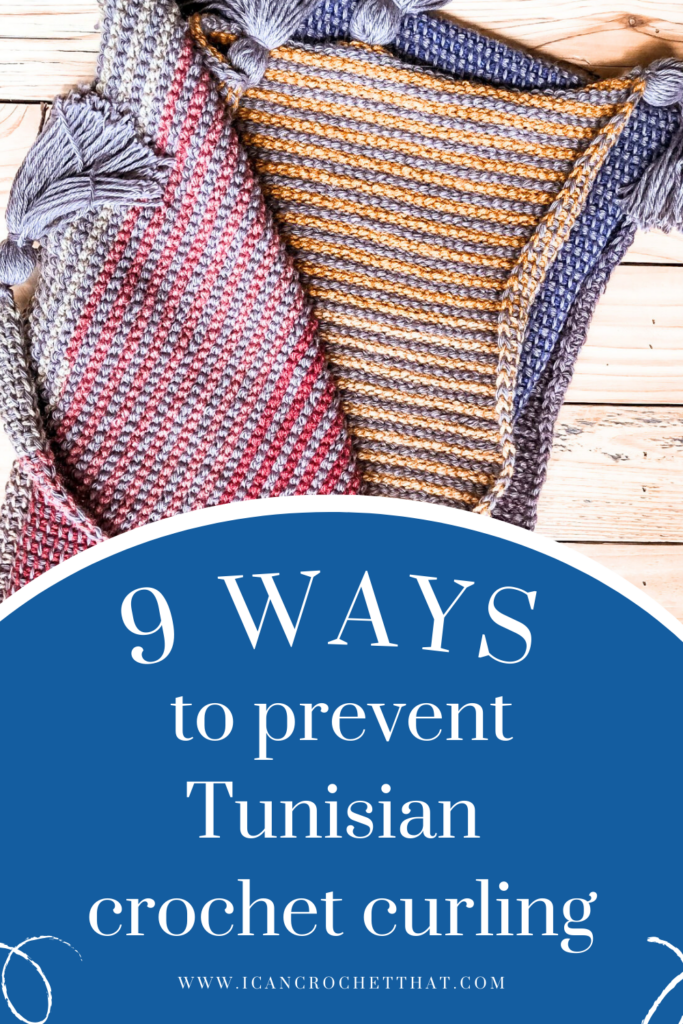
The Importance of Tension Control
Keeping the right tension in Tunisian crochet is also crucial. It affects how your finished project looks and hangs. Tight tension makes the fabric curl in, while loose tension makes it curl out.
By controlling your tension, you can ensure your Tunisian crochet looks flat and beautiful. Keep an eye on your yarn tension and hook grip as you work to get the look you want.
9 Ways to Deal with/Prevent Tunisian Crochet Curling
Key takeaways from below:
- Choose the right yarn
- Choose the right hook
- Block your projects
- Start with the honeycomb stitch
- Start with a row of half double crochets
- Do a row of post stitches
- Incorporate a non curling Tunisian stitch border
- Start with a Tunisian reverse stitch row, followed up by a Tunisian purl stitch row
- Try one of these Tunisian crochet stitches that have little to no curl
Choosing the Right Yarn and Hook
Choosing the right yarn and hook is crucial to solving the Tunisian crochet curling issue. The right pair can help you achieve the perfect tension and stitch definition, which prevents unwanted curling.
When picking yarn for Tunisian crochet, use natural fibers like wool, cotton, or linen. They give your stitches the structure and stability they need.
Synthetic yarns can cause uneven tension and make curling worse. But, if you're like me and love acrylic, you deal with the curl best so you can use your favorite yarn.
For Tunisian crochet hook size, a hook one or two sizes larger than the yarn's recommended size usually works best. This size helps with the Tunisian stitch height and keeps the fabric flat.
- For best yarn for Tunisian crochet, choose natural fibers like wool, cotton, or linen.
- When choosing Tunisian crochet hook recommendations, choose a size one or two larger than the yarn's suggested hook.
- The right Tunisian crochet hook size is crucial for perfect tension and stitch definition.
By picking the right yarn and hook for Tunisian crochet, you're on your way to making stunning projects without curling. It's all about finding the right balance between fiber and tool for beautiful Tunisian crochet pieces.
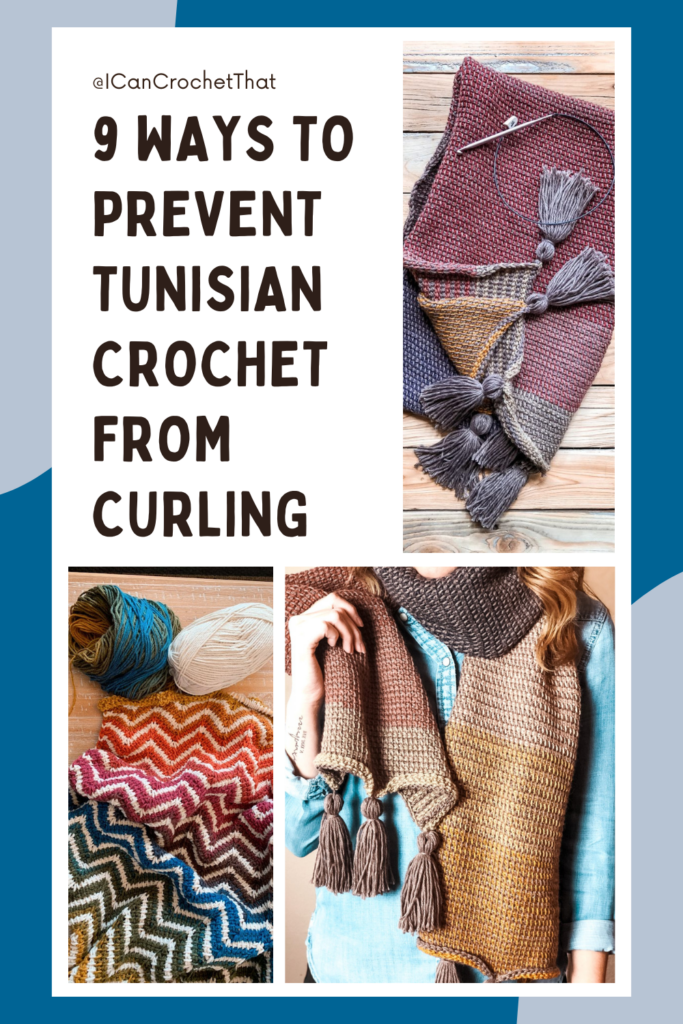
Blocking Techniques to Prevent Curling
Blocking is another way to control Tunisian crochet's curling issue. As a seasoned crocheter, I've found the right blocking methods make a huge difference. They help you get a smooth, flat finish for your projects.
Let's explore the best blocking techniques to say goodbye to curling edges.
Wet blocking is a top choice and works well. You soak your finished Tunisian crochet in water with a wool wash, then squeeze out the extra moisture. Next, pin it to a blocking board or surface. The water's weight and the pins' tension relax the stitches and flatten the fabric.
- For best results, use a blocking mat or surface with a grid pattern to ensure even tension across your work.
- Allow the piece to fully dry before removing the pins to lock in the flat shape.
Steam blocking is another great option. It involves using a hot steam iron near your Tunisian crochet and pressing the fabric gently. The steam's heat and moisture relax the fibers and flatten the stitches.
- Hold the iron in one spot for only a few seconds to avoid over-steaming and distorting the fabric.
- Work in small sections, moving the iron across the piece until the entire surface is steamed and flattened.
No matter the blocking method you pick, success comes from patience and detail. Mastering these techniques will help you make beautiful, flat Tunisian crochet pieces.
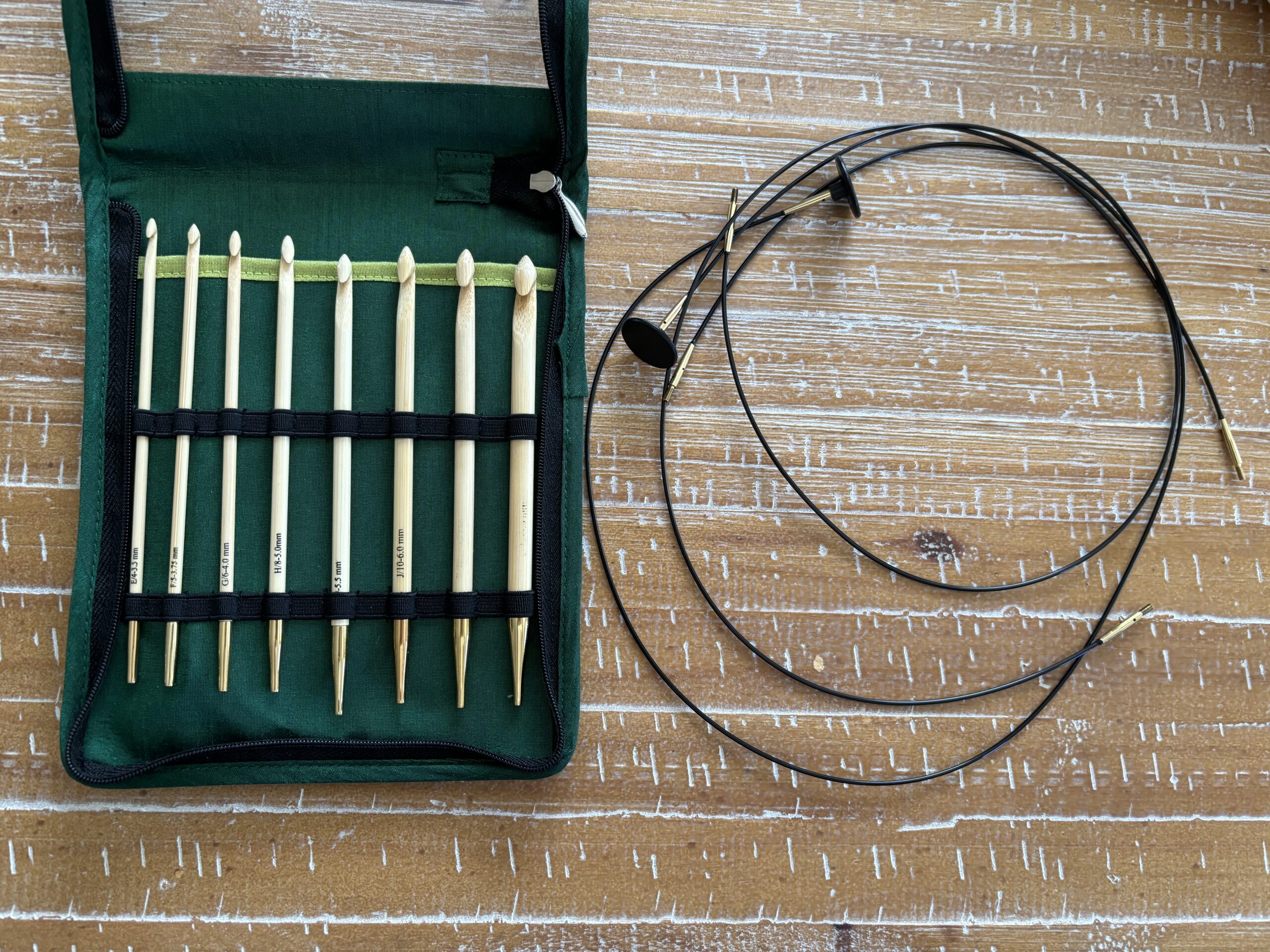
A Few Helpful Tips from Our Private Tunisian Crochet Facebook Group
Did you know we have a private Facebook group dedicated to Tunisian crochet? It's true, and you can ask to join here. This group is incredibly kind in helping answer questions. It's also just a fun, positive place to hang out with other crocheters.
One of the most common questions asked in the group is about curling. Here are some ideas and techniques that have worked for them:
I have found doing a honeycomb border around the whole blanket is very effective. Just have to work the stitches at the beginning and end of each row and the top and bottom whole making the blanket. Could just do it at top and bottom as well I suppose but I haven't tried that. Looks nice too!
Deanna
I always start with a row of half double crochet before I begin my Tunisian crochet. I have tried using a larger hook but sometimes that doesn’t work for the pattern.
Raymond
I was doing a very curly blanket and the curling was so annoying. I knew that I would correct it with a nice heavy border but it was making me crazy with the curling getting in the way while I was working on it. I took a heavy yarn and, from the back, I did a row of crochet post stitches to force it to go in the other direction. It worked perfectly. Once I was finished, I took off the temporary row and put on my border.
Kim
I usually incorporate a non curling Tunisian border into the pattern. I find working up a swatch helps to know what stitch will curl, how bad, what hooks size helps to reduce the curl and if my testers are a lifter, rider or yanker so I can help them adjust hook size for a design as well. You can also use a Tunisian envelope border afterwards.
Jessica
I just read to help stop the curl to do the chain, pick up stitches in the back bump then reverse row, then a row of purl stitch with the reverse row. (The purl stitch is quite easy. Do you Youtube to learn stitches?) It curls because of the bulk of the yarn being in the back of your project. The purl will help put some weight to the front. (I just learned this also.)
Marj
Tunisian Crochet Stitches with Minimal to No Curling
Luckily, some stitches and patterns help make flat, curl-free pieces. Let's look at some options for making beautiful Tunisian crochet items without the curl.
The basic Tunisian stitches that all beginners start with are, unfortunately, some of the ones that curl the worst! I'm talking to you simple and knit stitch.
Tunisian crochet stitches that have minimal to no curling:
Tunisian half double crochet stitch
Tunisian crochet wave stitch
Tunisian crochet mesh stitch
Tunisian crochet reverse stitch
Minimal to No curl Tunisian crochet patterns:
The Quinn Crochet Camping Blanket
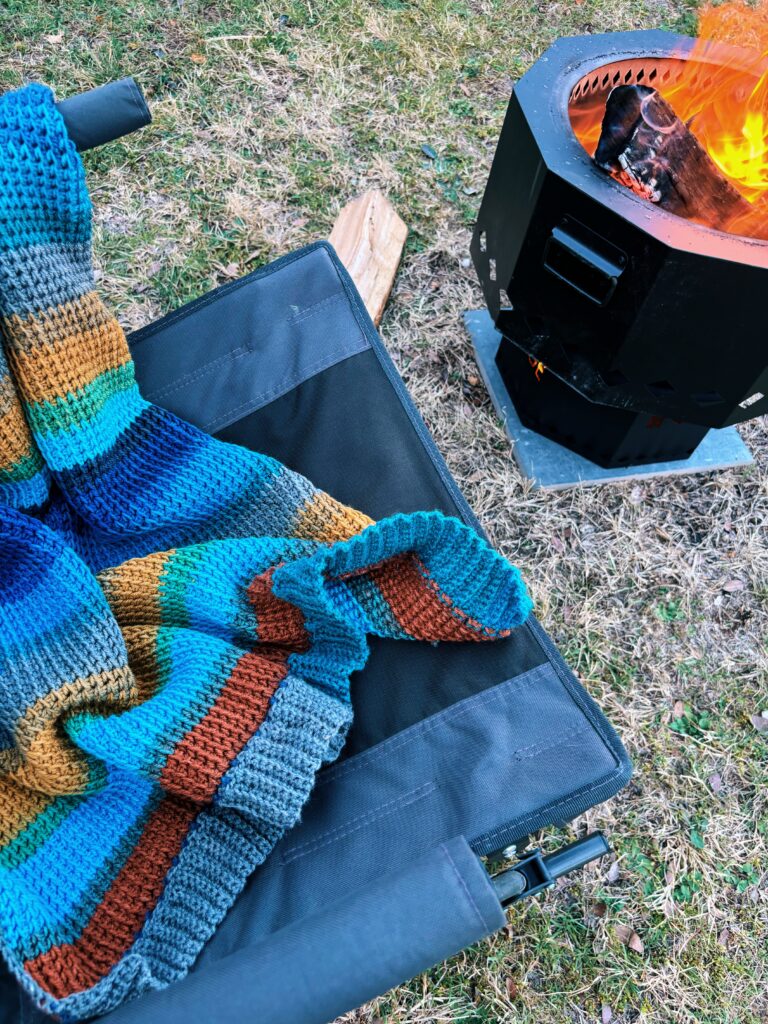
Tunisian Crochet Ear Warmer Pattern
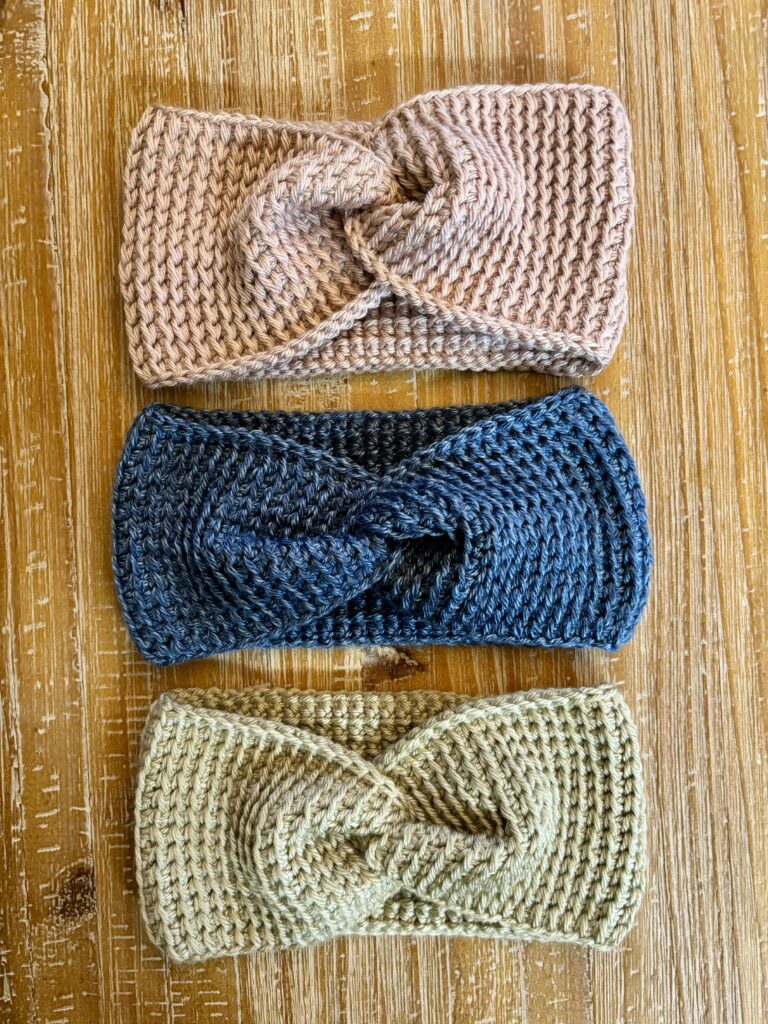

Tunisian Crochet Rectangle Placemat Pattern
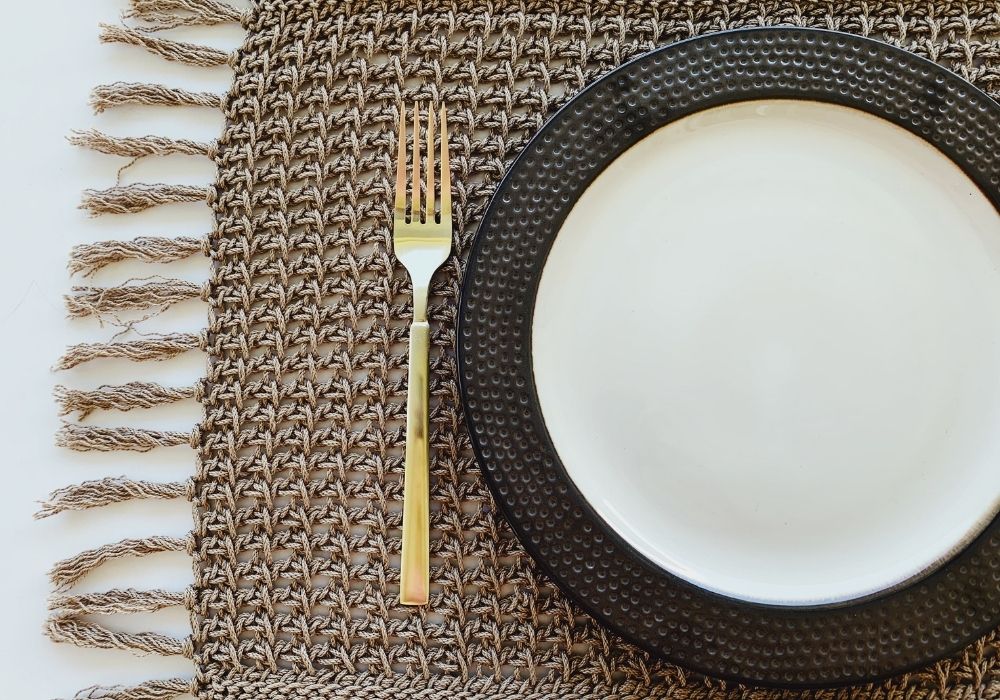
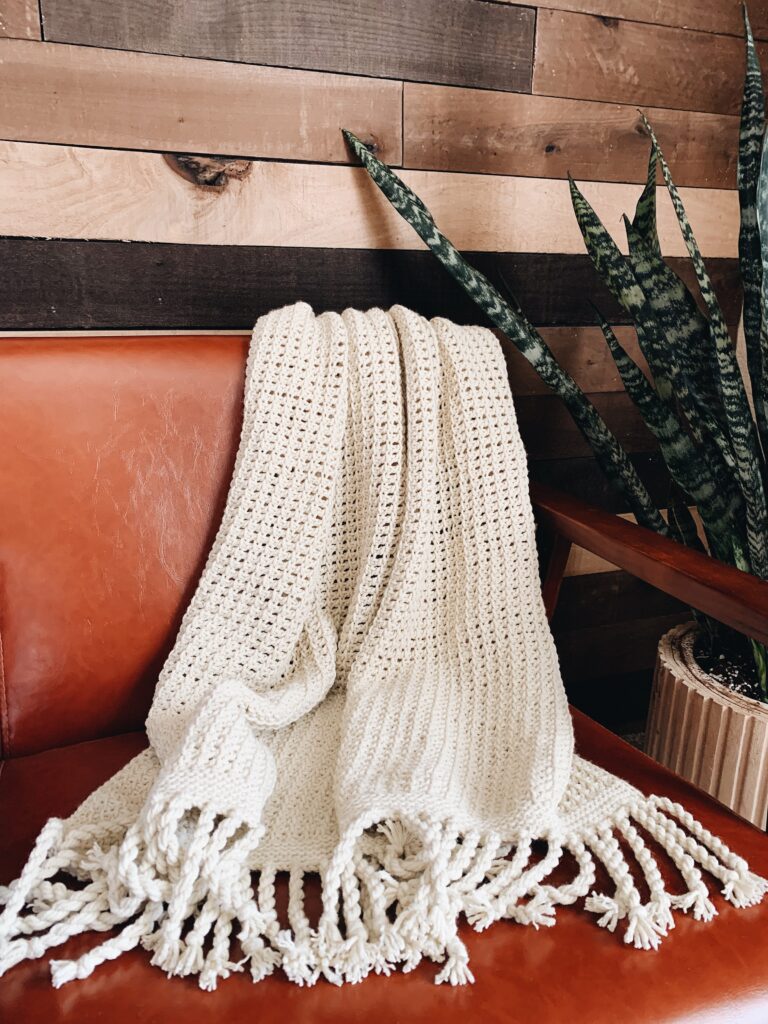
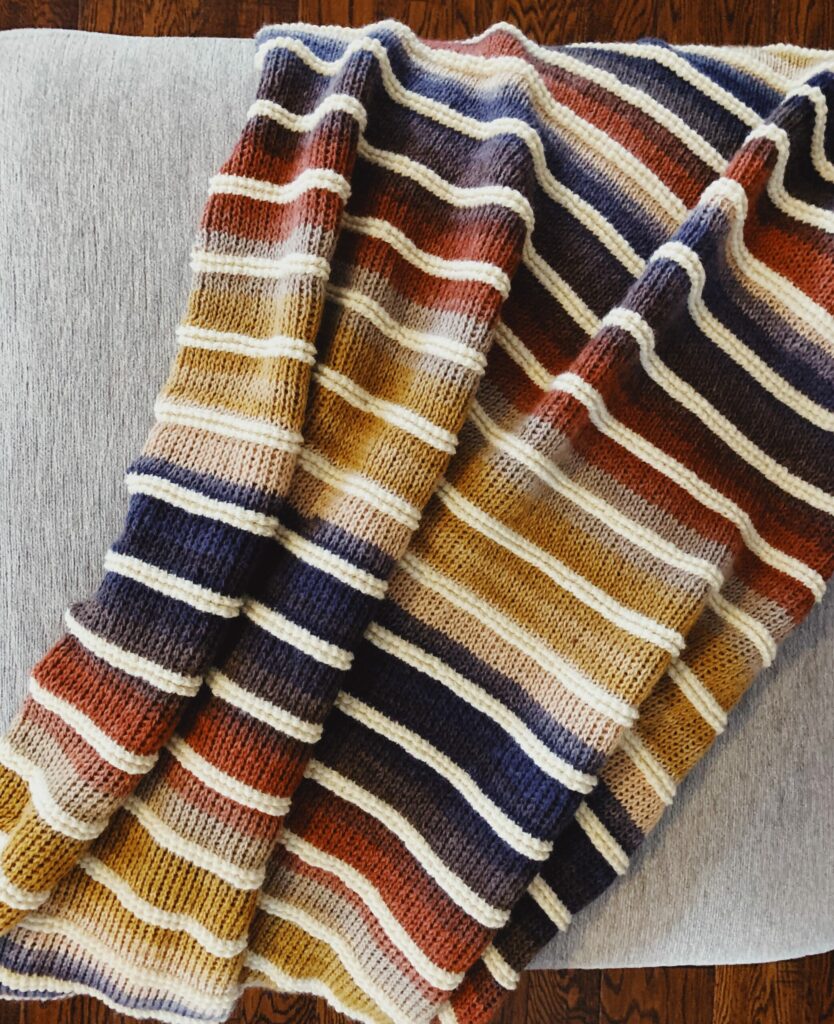
Choosing the right Tunisian crochet patterns and techniques lets you make beautiful, curl-free items. Try different patterns to find what works best for you.
FAQs: Tunisian Crochet and Curling
1. Why does my Tunisian crochet curl?
Tunisian crochet often curls due to the way the stitches are formed. The Tunisian Simple Stitch (TSS), in particular, tends to lean forward as you work, which causes the fabric to curl inward. The dense nature of the fabric, with multiple loops held on the hook, creates tension that contributes to this curling effect.
2. How can I prevent my Tunisian crochet from curling?
To prevent curling, consider using a larger hook size than you would typically use with your yarn. This can help loosen the tension and create a more flexible fabric. Additionally, you can try using different stitch patterns that naturally counteract curling, such as alternating rows of Tunisian knit stitch or purl stitch. Blocking your finished piece is another effective way to reduce or eliminate curling.
3. What is blocking, and how does it help with curling?
Blocking is when you dampen or wet your finished crochet piece, shape it, and then allow it to dry in the desired shape. This method helps relax the fibers and significantly reduces curling in Tunisian crochet. You can block your work by spraying it with water, steam blocking it with an iron, or soaking it in water and then pinning it to a flat surface to dry.
4. Does the type of yarn affect curling in Tunisian crochet?
Yes, the type of yarn you use can impact the degree of curling in Tunisian crochet. Yarns with a lot of elasticity or a tighter twist are more likely to cause curling. Opting for a yarn with less stretch, such as cotton or a wool blend, can help minimize curling. Experimenting with different yarns can help you find the best match for your project.
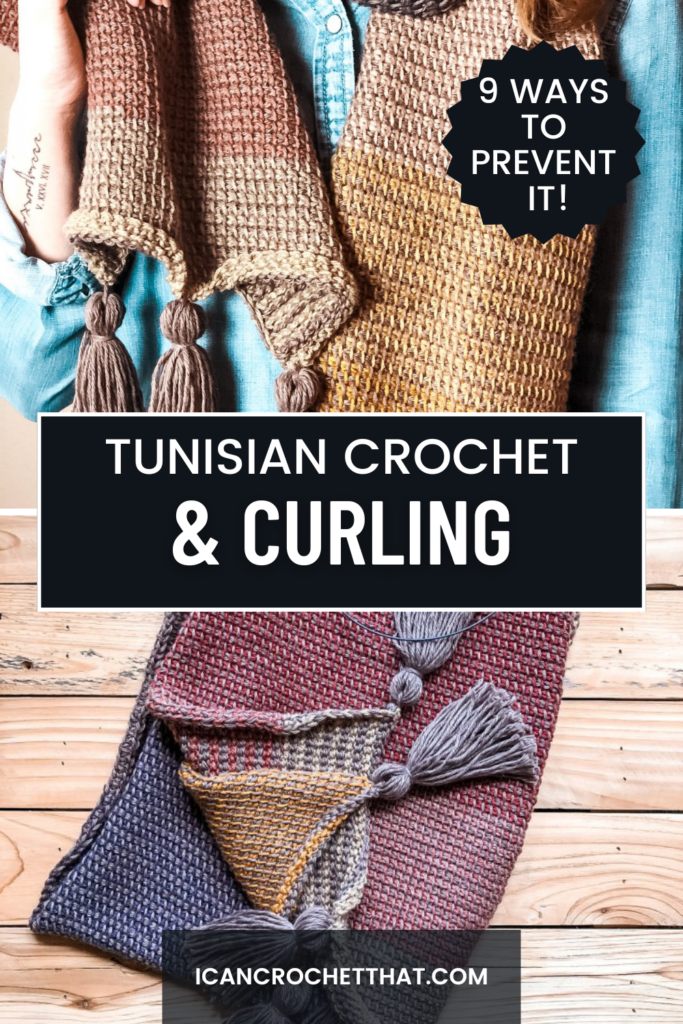
5. Will using a different stitch help reduce curling?
Incorporating different stitches can help reduce curling in your Tunisian crochet projects. For instance, alternating rows of Tunisian knit stitch or Tunisian purl stitch with the Tunisian simple stitch can help balance the tension and reduce curling. Experimenting with different stitch combinations can provide a more balanced fabric that lays flatter.
6. Can I fix curling after my project is finished?
Yes, you can address curling even after your project is finished. Blocking is one of the most effective ways to fix curling after the fact. You can also add a border using a different stitch, such as a single crochet or a slip stitch, to help stabilize the edges and reduce curling.
7. Is curling always a bad thing in Tunisian crochet?
Curling isn't always a problem; it depends on the desired outcome of your project. For some designs, a natural curl can add texture and character. However, understanding and managing curling is essential if you're aiming for a flat piece.
8. Should I always block my Tunisian crochet projects?
While not always necessary, blocking is highly recommended for Tunisian crochet projects where curling is a concern. It helps smooth the fabric, even out stitches, and achieve a professional finish. Blocking is particularly beneficial for larger projects like blankets or garments.
9. Can tension affect curling in Tunisian crochet?
Absolutely! Your tension plays a significant role in how much your Tunisian crochet curls. The fabric is more likely to curl if your tension is too tight. Relaxing your grip on the yarn and using a larger hook size can help create a more relaxed fabric that curls less.
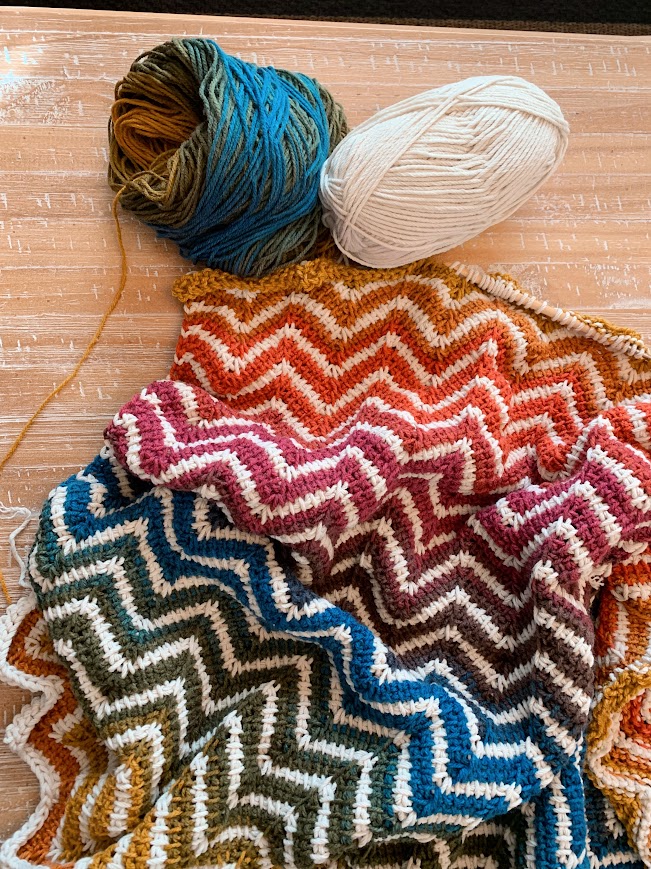
Let's Wrap This Up
As we conclude our exploration of Tunisian crochet curling, I hope you now feel more confident about achieving flat, smooth stitches. We've discussed why curling occurs, how to manage your tension, and the ideal yarn and hook combinations.
Additionally, we covered blocking techniques to help eliminate any stubborn curls. And we've shared Tunisian crochet stitches and patterns that have minimal to no curling.
To sum it up, remember to monitor your gauge, adjust your tension as needed, and experiment with different blocking methods to find what works best for you. With these strategies in hand, you'll be able to create stunning, curl-free Tunisian crochet pieces that you’ll be proud to display.
The world of Tunisian crochet is always evolving, offering endless opportunities to learn and grow.
Embrace the journey, continue experimenting, and explore this captivating crochet technique. I wish you all the best as you enhance your Tunisian crochet skills and create beautiful, flat projects that reflect your unique creativity!


